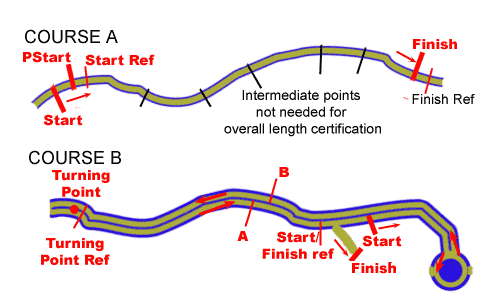I am developing a software script to produce course measurement reports, and I want find out what is the most challenging set of data a measurer is ever likely to want to process.
Firstly I should define my terms:
RIDE: I define this as a continuous measuring ride along the shortest allowed running line with counts recorded at beginning and end, and often intermediate locations.
PIECE: is the name I have given to a portion of a ride which one needs to add to other PIECEs to make up the whole course. Perhaps someone can suggest a better name of a PIECE of a course. A PIECE may contain several intermediate points, and could be divided into shorter PIECEs, but to reduce complexity in the presentation of the overall course length I prefer not to divide up PIECEs unnecessarily.
A single measurement of a whole course consists of a number of PIECEs taken from a number of RIDEs.
A single PIECE has a PIECE STARTING LOCATION (and COUNT) and a PIECE FINISHING LOCATION (and COUNT). The PIECE when used to make up the course may be run in the direction of measuring, or in the opposite direction if that bit of course was measured backwards.
One clear way of organising a measurement report is to present the PIECEs in a PIECE SEQUENCE which is identical to the order that a runner traverses them from START to FINISH. This makes it easy for both the race director and the certifier to follow the calculation. Of course in addition to this simple presentation of the overall length, split distances and their references must be presented. Measurers may opt to present all their ride data even for references which are not needed for certification.
I sometimes find that I take several PIECEs from a single RIDE. Sometimes there are many RIDEs to deal with.
As well as PIECEs taken from RIDEs, there may be PIECEs taken from taped measurements.
In my script I can easily make provision for more than enough (thousands !) of RIDEs, but I need to decide what is the maximum number of PIECEs that need to be taken from a single RIDE. For example when I measured a marathon recently I had 2 RIDEs, and I took 3 PIECEs from one RIDE, and 2 PIECEs from the other, and then added two taped PIECEs to make up the full course.
Obviously, if there is more than one LAP the number of PIECES from a ride would be multiplied by the number of LAPs and so could be very large. However, I can introduce into the hierarchy the concept of a repeated identical LAP. So I am really seeking the largest number of PIECEs per RIDE ignoring multiple identical LAPs.
The reason I ask this is that I have to decide how to lay out the computer screen where the PIECEs will be defined by the measurer selecting from a table of the available RIDE LOCATIONs( and COUNTs). There is enough room on the screen to provide for about 5 different PIECEs from from a single RIDE. Should I try to cram in more?
So my question is:
What is the maximum number of PIECEs a measurer is likely to need to take from a single RIDE in order to put together a single set of data representing one complete measurement of the course? A different set of PIECEs will be required if it is desired to get second fully independent measurement of the length.
N.B. clarifications, shown in italics, were added on 2 March
Original Post

